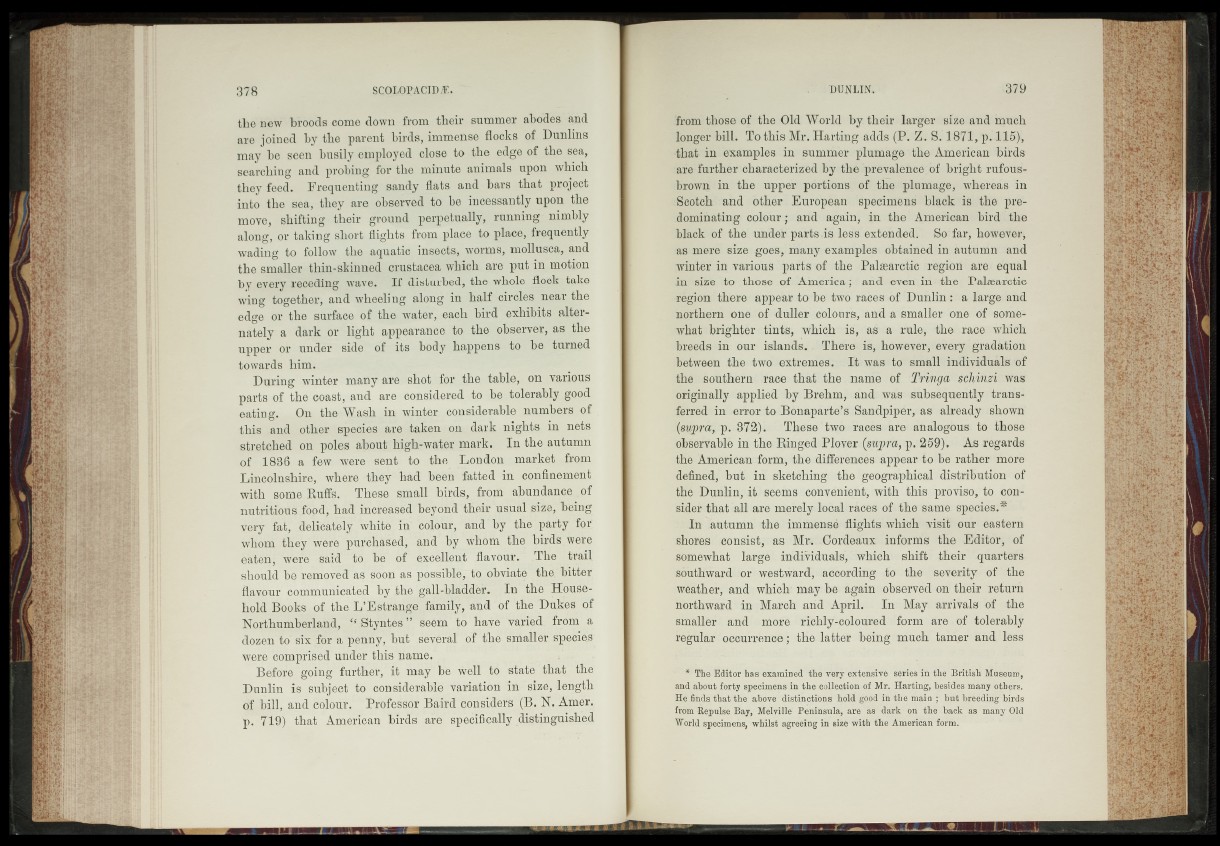
the new broods come down from their summer abodes and
are joined by the parent birds, immense flocks of Dunlins
may be seen busily employed close to the edge of the sea,
searching and probing for the minute animals upon which
they feed. Frequenting sandy flats and bars th a t project
into the sea, they are observed to be incessantly upon the
move, shifting their ground perpetually, running- nimbly
along, or taking short flights fropi,plape to place, frequently
wading to follow the a q u a ||| mollusca, and
the smaller thin-skinned crqstacea which are put in motion
by every receding wave. If disturbed, the whole flock take
wing 'together, and wheeling along in half circle^ near the
edge or the surface of- th>P water, each bird exhibits alter-
n i t t y a dark or light appearance te the; observer, as the
upper or u n d e r'sid e of its body happens to be turned
towards him.
During winter manyafe- hhot for the table,, on various
parts of the coast, and- are considered to -be' toler.ab'Iy^gqod
eating. Qn the ^fash in winter. c» si.de|able numh§£ft °f
this .and other species- are taken .Qn,. dark nights, in .nets
stretched on poles about high-water mark. In ;i%| autumn
of' 1886 a few' were sent-'to -the London; market .from
Lincolnshire, where -t-h'ly® had beemlfatted in ':cSnfin.ement
with some Ruffs. The.86 sma11 P<W. abundance,, of
nutrilibu|,fopd^ had inciaased'^feVond then^usual'^ize, being
very fat, delicately t whitt t t° ,ur’ and by ‘ tpe „party ~fQf
whom they were purchased, and' by^whom, the biros,WCre
eatfin? were said W^of excellent flavour! Tlhf trail
; Snopld ne removed asgobii p o '^ ^ ^ th ^ n ia te thCrntter
flavour communicated Ay ^h^gafehlad^^V In th'e IIoh|e~
hold Books of th e ^FM ra ^ eJfam^, and "of jtle "Dqkes’pf
Northumberland, ^ ty n te s '”’ seemf |o have' vari^d. from a
sS^for h^enn^hut^se^pvar o f the snialleiHppcie's"
were comprised under ^Bis .name.
Befd^gom'l" 'further, it may* be weif’ to -stale' that ffie'
Dunlin is subject"to considerable varlatloddm size, ieig-th
Of bill, and colour. Professor
p. 7 l9 f th a t/'A m e rS birds a^'"spccmcally distinguished
'from those of the Old World by their larger size and much
longer bill. To this Mr. Harting adds (€?-. “Z. S. 1871, p. 115^
-that in examples in summer plumage * the'American birds
are further characterized by the prevalence;bf bright rufous-
brown in' the upper portions of the plumage, whereas in
-Scotch and other - European specimens black is the predominating
colour; and again, in the Americam-dbird. the
black of the under parts,is le^£ extended;. So? far, bowe$®r|
as mere size goes*, many examples obtained in autumn and
winter in various pact's of the Palsearctic asegiod are equal
i n ’size to those of. America /i- and, even; in - the; Palaearctic
»régi on!there appear to be two races^of? Dunlin : a large and
northern one ;ofe duller _C®1oueb, and a smaller *.one of som'ei
*wHat-bïightér- tintsj which' is, -as a- -rtde,hther.raei| which
breeds in owe islands.'. There- is, however, every > gradation
between the two extremes. It wasi to* small- individuals of
thé- southern -race that tthe. name - óf 'Trïnga-SëhïMii was
originally applied by Brehm, and was subsequently transferred
in' eriortolBóhapartó’s Sandpiper/as already- tshown
fywpra, p. 87%i® These'two 'races,are- analogous to those
obèervahlè in the, R i n g e d * P l o V e r 259). As regards
tSè Amrericaucform, the differences appear€o&Ie rather more
defined, but in sketching- th e ' geographical distribution of
the Dunlin, iö séems /convenient, with this-p®iw@/tó-consider
that-all are japlfly^ocal races of the same, species;**
i';fh autumn the immense flights; which visit our eastern-
shores èisnsifetgnas Mr. -Cordeaux informs the Editor, oof
somewhat large. individuals;,! which- shift- their .quarters
southward for'.« westward, according io - the* severity*? of’ the
weather/land^which- may; be»againAobserwëd- on theh ’reiufch
northward in -March and April. ’ In 'MIaj®-arrivals óf thé
smaller and . more ' richly ^coloured /form are of -tolerably
regular occurrence \ tfle-ilatter bëihgsmuch tampr and -fe^s
1 *"The-Eciifor ha'röramï&m the very extensivè sefies^ïn imrBriti’sB Museum,
and about forty specimens in the- coUe<$i.oni®f Mr, Harting, besides many'others.
He finds that the abovb-f'd'isfin^fiob.^bold^op^n -ihc main ; hut breedinglbirds
from Êepulse Bay, Meljffiè’ Peninsula,-are as dark on the tael?; as many O lt
World specimens, whilst agreeing in size with the American‘form.